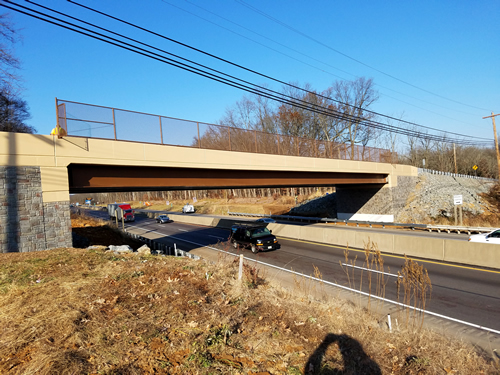The reconstruction and widening of the Pennsylvania Turnpike's Northeast Extension (I-476) between mileposts A38-A44 involves the addition of travel lanes and the removal and replacement of five bridges. According to Section 106 of the National Historic
Preservation Act (NHPA1966), Federal agencies must consider the effects of federally funded, licensed, or permitted projects on historic properties and afford the Advisory Council on Historic Preservation (ACHP) an opportunity to comment on such
projects.
A historic property is any property that is included in, or eligible for inclusion in, the National Register of Historic Places (NRHP). NRHP listed or eligible properties fall into five broad categories: Buildings, Structures, Sites, Objects, and
Districts. As nearly every major turnpike project requires permits from federal agencies like the U.S. Army Corps of Engineers, an archaeological survey is routinely a part of the planning process needed in order to comply with the NHPA and 36CFR
Part 800, the Advisory Council on Historic Preservation regulations that implement the NHPA, Section 106 process. Determining the effect of any project on archaeological resources is, therefore, an important component of the planning process for
any transportation project and the PTC MP A38-A44 project is no exception.
Archaeological investigations typically involve three phases. Phase I identification survey is a reconnaissance survey which is often subdivided into Phase IA and Phase IB. Phase IA survey is the most basic type of survey focused on establishing the
environmental, Pre-contact, and Historical contexts for the project area. To do so, sources like historic maps and primary documents, scholarly research, and state archaeological site files are examined to identify the locations of former buildings
and or sites of notable events in and around the project area. At the Phase IA level, the probability of encountering prehistoric sites is assessed by identifying known site locations in the area and identifying areas in the environment that share
environmental similarities with those places that prehistoric peoples are known to have occupied. If at this stage it is determined that the project area will have no effect to historic properties, or areas likely to contain an archaeological
site (a discreet location containing evidence of past human activity) then no further archaeological work is needed and the Section 106 process has been completed. However, if the Phase IA survey indicates that the project area has the potential
to contain archaeological sites, then field testing is conducted. This initial fieldwork is commonly called a Phase IB survey.
The purpose of Phase IB survey is to identify the presence of archaeological deposits and, where possible, delineate the boundary of an archaeological site. Once an archaeological site is identified a Phase II archaeological investigation may be conducted
to assess its NHRP eligibility.
During a Phase II archaeological investigation, a more robust sample of the soils within the site is examined, recovered artifacts are analyzed, and an attempt is made to determine the function and temporal association of the site. If, at the conclusion
of the Phase II investigations, archaeologists determine that they have a site that meets NRHP eligibility requirements, recommendations are made to either attempt to avoid or minimize project effects to the site. If avoidance is not possible,
then efforts to mitigate the effects are determined through coordination with project consulting parties, usually resulting in a Phase III Data Recovery excavation of the site.
Phase III data recovery excavations endeavor to collect and record significant information from the site by collecting and analyzing artifacts, mapping of the cultural features (i.e. foundations, pits, privies, wells, graves, hearths, pits etc.).
Such excavations preserve a record of the spatial relationships of the material recovered thus maintaining a record of what occurred there.
The PTC Northeast Extension Milepost A38-A44 project has included archaeological work covering all phases of archaeological investigation described above. For more information about the work completed during each phase, click the appropriate link
below.
 Safety
Safety Pavement Condition
Pavement Condition Capacity
Capacity Corridor Completion
Corridor Completion





